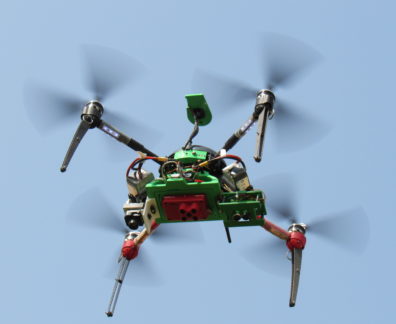BSE552: UAS in AG

Number of credits: 2
Prerequisites: None, Departmental permission maybe required [Enrollment limit: 20 max]
Semester & year: Spring 2017, 2018, 2019, 2020; 2023
Instructor name: Lav R. Khot
Office location: Prosser (IAREC Ag Tech Building 109); Pullman (L. J. Smith Hall 206)
Office hours: Prosser (Monday 1 to 3 pm); Pullman (Thursday 9 to 11 am)
Contact information: Phone 509-786-9302, E-mail: lav.khot@wsu.edu; Skype: lavkhot
Course overview: In past few years, the unmanned aerial systems (UAS aka drones) have fascinated farmers and researchers alike with versatile imaging and non-imaging application capabilities. Agribusiness industry is trying to keep pace with rapid developments in this sector. This course provides comprehensive understanding of the fundamentals of UAS technology, optical sensing principles and types, sensor integration/ calibration methods, basics of imagery data analytics, available open source and commercial tools as well as current Federal Aviation Administration (FAA) rules (Part 107), local regulations and safety aspects.
Student learning outcomes (SLO):
| Student learning outcomes | Assessments |
| Know principles of flight and basics associated with different components of unmanned aerial system (UAS); how they integrate as a system, associated do’s and don’ts | Quizzes and exams |
| Know how to configuration, calibration UAS, field mission planning and hands-on UAS flight training | In-class and field activities, exams |
| Familiarize with remote (optical) sensing principles, sensor types and output data formats, data quality matrices | Quizzes and exams |
| Know the basics steps in data analytics, how to analyze the imagery data using open source and commercial data processing tools/software(s) | Quizzes and exams |
| Know current UAS operational rules and regulations (FAA Part 107 knowledge test basics). Understand ethics & privacy associated with UAS flights and data use | Quizzes and exams |
| Gain insight into the application domain of UAS within regional agribusiness sector | Quizzes and exams |
Meeting Schedule:
Classes: January through March [Tuesday & Thursday from 4:10 to 6:10 pm]
Hands on: Attend either at Pullman, WA or Prosser, WA
Week-to-week course outline:
| Topic #1 UAS Platforms | |
| Jan 21 | Principles of flight
UAS types & classifications UAS basics & component integration 1 Airframe Power train (Motor, Propellers, Power supply, etc.) Flight controller |
| Jan 23 | UAS basics & component integration 2
Navi controller GPS receiver, compass, battery monitor Transmitter and Telemetry radios |
| Jan 28 | UAS configuration, calibrations & mission planning |
| Topic #2 Optical sensors & data analytics | |
| Jan 30 | Optical sensor types & output data formats
Integrating sensor(s) with small UAS Best practices in UAS imagery data collection Data product & quality metrics |
| Feb 4, 6, 11 | Overview of data processing tools (open source & commercial)
UAS imagery data (pre- and post-) analysis: basic steps Data analytics with Pix4DTM (w/ Hands-on) Pix4DMapper overview Image stitching and radiometric corrections Vegetation indices and prescription maps |
| Feb 13, 18, 20 | Data analytics with open source QGIS (w/ Hands-on)
QGIS overview Resampling and georeferencing Background removal Generating vegetation index layers Perform zonal statistics Agricultural application case studies |
| Topic #3 UAS operational rules and regulations | |
| Feb 25, 27 | Rules, regulations & safety
UAS operations (FAA Part 107 knowledge test basics)-1 |
| Mar 10, 12 | UAS operations (FAA Part 107 knowledge test basics)-2
Ethics & privacy |
| Topic # 4 Hands-on training | |
| March 9 (Prosser)/ 13 (Pullman) | WSU field sites (Time: 4 h) |
Recommended textbooks, materials and resources:
- Beard, Randal W. & Timothy W. McLain. 2012. Small Unmanned Aircraft: Theory and Practice. ISBN: 9781400840601
- Kilby, Terry & Belinda Kilby. 2015. Getting Started with Drones: Build and Customize Your Own Quadcopter. ISBN-13: 78-1457183300
- Barbara G. Grant. 2016. Getting Started with UAV Imaging Systems: A Radiometric Guide. ISBN: 9781510601833
- Khot, L. R., Q. Zhang, M. Karkee, S. Sankaran, K. Lewis. 2016. Unmanned aerial systems in agriculture: part I (systems) – UAS in Ag Series (FS194E)
- Khot, L. R. 2017. Unmanned aerial systems in agriculture: part I (Sensors) – UAS in Ag Series (FS285E).
- 2016. Remote Pilot – Small Unmanned Aircraft Systems (sUAS) Study Guide. FAA-G-8082-22. Available online at: https://www.faa.gov/regulations_policies/handbooks_manuals/aviation/media/remote_pilot_study_guide.pdf
- Eastman, J. R. 2001. Guide to GIS and Image Processing Volume 1 http://www.clarklabs.org
- Eastman, J. R. 2001. Guide to GIS and Image Processing Volume 2 http://www.clarklabs.org
- Relevant peer-reviewed journals: Precision Agriculture Journal ISSN: 1385-2256; International Journal of Remote Sensing ISSN: 1366-5901
Required fees:
No fees; Students may need to use personal mode of transportation to travel to nearby WSU research farms for hands-on training components 1 to 2 such trips are expected). For term homework assignments that involve imagery data analysis, students are expected to use personal laptops.
Expectations for student effort:
Students are expected to spend a minimum of 2-hours per 1-h of classroom instructions. They are expected to be engaged in the following types of activities: reading, listening, completing assignments, and reviewing instructor feedback, studying for and completing assessments, etc.
Course assignments:
Homework: Typically, four homework’s will be assigned at the weekly frequency (i.e., 1/ week). Read specific deadlines of submission on the assignment. The homework’s are required to be presented (reported) in a professional manner, with appropriate units, written in complete sentences, proper formatting, and explained steps.
In-class Quizzes: There will be two random quizzes, at the bi-weekly frequency.
Class Participation: The class participation will be assessed based on in-class discussions.